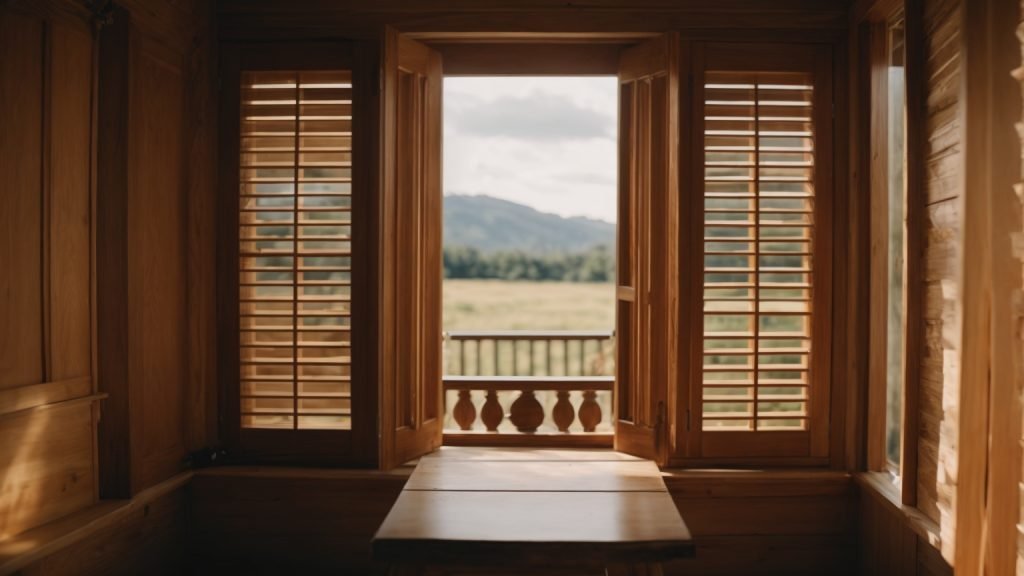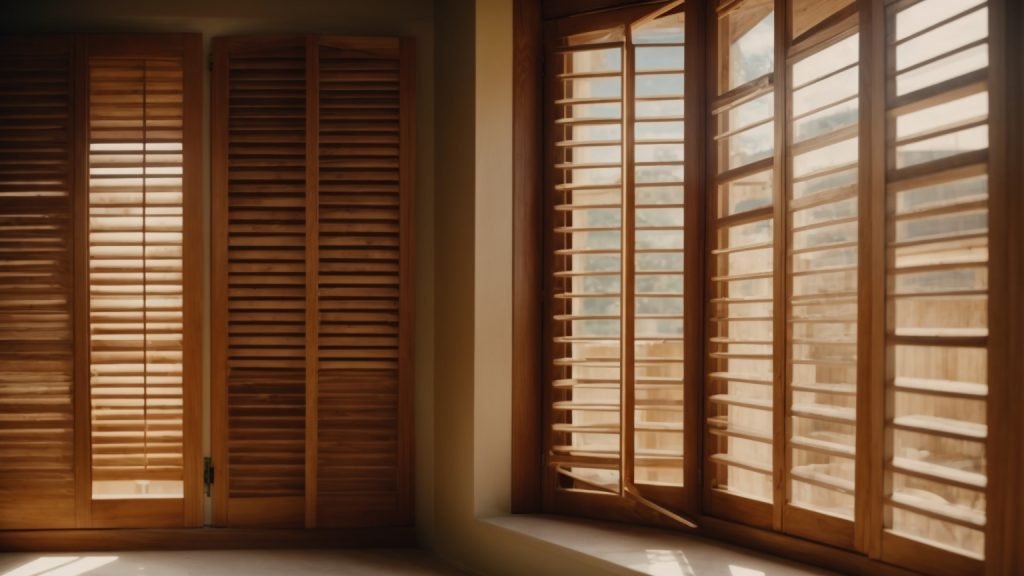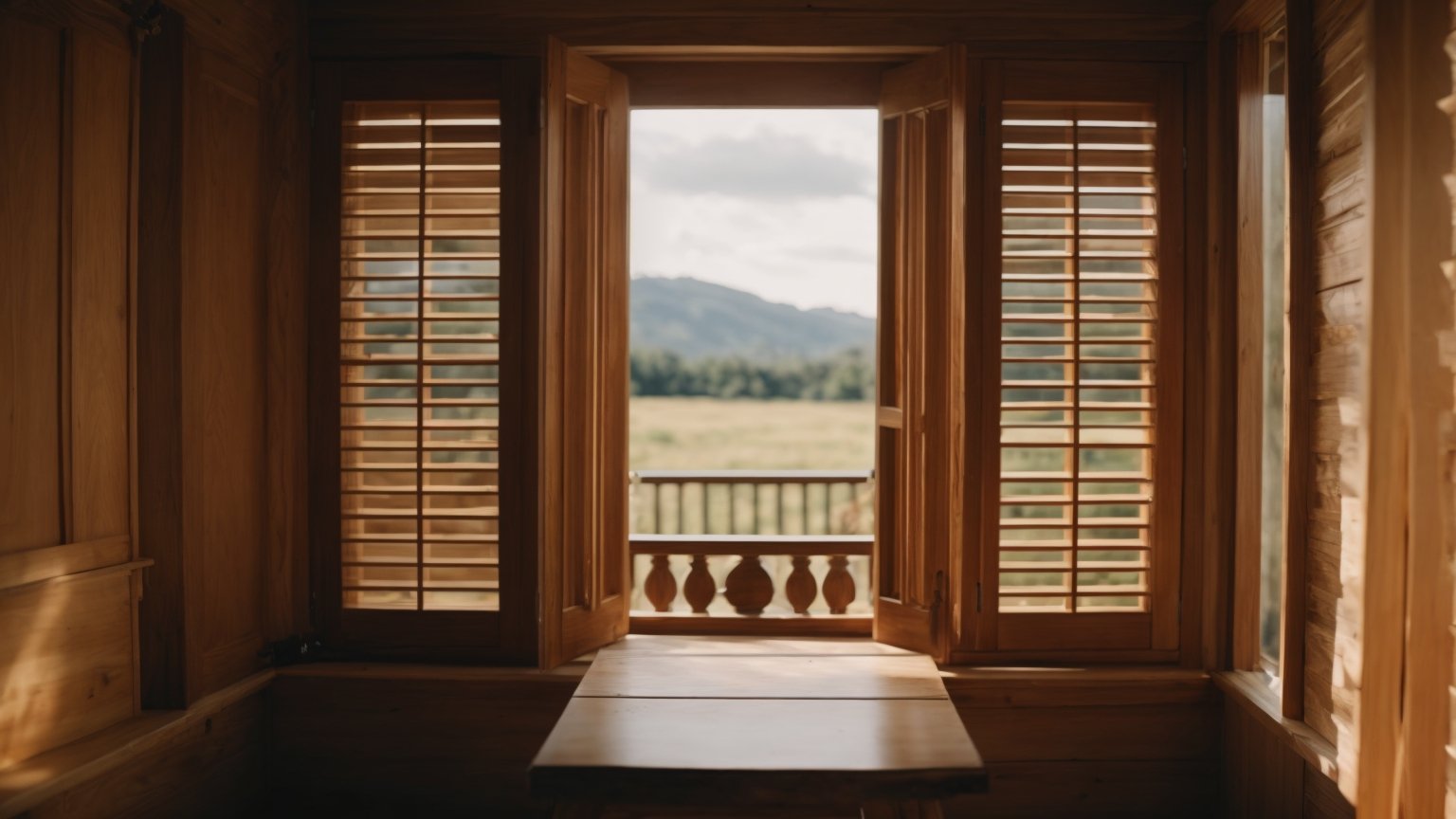Are you looking for a way to add some charm to your home’s exterior? Wooden shutters can be a great addition to any home, providing both aesthetic appeal and functionality. With a little bit of effort and some basic woodworking skills, you can build your own custom shutters that perfectly fit your windows and match your home’s style.
Before you get started, it’s important to consider the purpose of your shutters. Are you looking to add some privacy to your home? Do you want to protect your windows during storms? Or are you simply looking to enhance your home’s curb appeal? Understanding your goals will help you choose the right materials and design for your shutters. Once you have a plan in place, building your own wooden shutters can be a fun and rewarding project.
Understanding the Basics of Wooden Shutters

If you’re looking for a way to add some charm and character to your home’s exterior, wooden shutters are a great option. They’re not only functional but also aesthetically pleasing. Before you start building your own wooden shutters, it’s important to understand some basic concepts.
Types of Wooden Shutters
There are several types of wooden shutters, including:
- Louvered shutters: These have angled slats that allow air and light to pass through.
- Raised panel shutters: These have a solid panel that’s raised above the frame.
- Board and batten shutters: These are made of vertical boards held together by horizontal battens.
Materials
The most common materials for wooden shutters are cedar and redwood. These woods are durable and naturally resistant to rot and insects. Other types of wood, such as pine or fir, can also be used but may not last as long.
Sizing
To determine the size of your shutters, measure the height and width of your windows. The shutters should be slightly larger than the window opening to ensure proper coverage. Keep in mind that shutters that are too small will look out of proportion, while shutters that are too large may overpower the window.
Hardware
Shutters are typically mounted to the house using hinges. You’ll need to choose the appropriate size and style of hinge based on the weight of your shutters. You may also want to consider adding decorative hardware, such as shutter dogs or holdbacks, to add some extra flair.
By understanding these basic concepts, you’ll be well on your way to building your own wooden shutters.
Choosing the Right Wood
When it comes to building wooden shutters, choosing the right wood is crucial. The type of wood you choose will affect the durability, appearance, and overall quality of your shutters. Here are some factors to consider when selecting the right wood for your shutters:
Durability
Wooden shutters are exposed to the elements, so it’s important to choose a wood that can withstand moisture, sunlight, and temperature changes. Cedar and redwood are popular choices because they are naturally resistant to decay and insect damage. Pine is also a good option for indoor and outdoor shutters since it’s durable and easily workable.
Appearance
The type of wood you choose will also affect the appearance of your shutters. Cedar has a warm, reddish-brown color and a distinctive grain pattern that can add character to your shutters. Redwood is also known for its natural beauty, with a rich, reddish hue that can complement a variety of home styles. If you prefer a more rustic look, elm wood shutters can give you a natural, weathered appearance.
Workability
Some woods are easier to work with than others, which can affect the installation process and the final look of your shutters. Pine is a soft wood that is easy to cut, sand, and finish, making it a popular choice for DIY shutter builders. Cedar and redwood are also workable, but they are harder and denser than pine, which can make them more difficult to shape and sand.
Cost
The cost of the wood will also be a factor in your decision. Cedar and redwood are more expensive than pine, but they are also more durable and have a more attractive appearance. If you’re on a budget, pine can be a good option since it’s affordable and readily available.
Overall, choosing the right wood for your shutters will depend on your personal preferences, budget, and the specific needs of your project. Consider the factors above and do your research to find the best wood for your shutters.
Gathering Your Tools
Before you start building your wooden shutters, it’s important to gather all the necessary tools. Here are the tools you will need to build your shutters:
Measuring Tools
To ensure that your shutters fit perfectly, you’ll need to use measuring tools. Here are the measuring tools you’ll need:
- Tape measure
- Speed square
- Pencil
The tape measure will help you measure the dimensions of your windows, while the speed square will help you ensure that your cuts are straight and accurate. Don’t forget to use a pencil to mark your measurements.
Cutting Tools
Once you’ve measured your windows, it’s time to start cutting your wood. Here are the cutting tools you’ll need:
- Circular saw
- Jigsaw
- Miter saw
- Table saw
The circular saw is great for making long cuts, while the jigsaw is better for curved cuts. The miter saw and table saw will help you make precise cuts at different angles.
Finishing Tools
After you’ve cut your wood, you’ll need to finish your shutters. Here are the finishing tools you’ll need:
- Sandpaper
- Paint or stain
- Paintbrush or roller
- Screwdriver
Sandpaper will help you smooth out any rough edges, while paint or stain will help protect your wood from the elements. A paintbrush or roller will help you apply the paint or stain evenly. Finally, a screwdriver will help you attach your shutters to your windows.
By gathering these tools before you start building your shutters, you’ll be well-prepared to create a beautiful and functional addition to your home’s exterior.
Creating Your Design
Before you start building your wooden shutters, you need to create a design that fits your windows and complements your home’s exterior. Here are some steps to help you create your design:
Step 1: Measure Your Windows
Measure the height and width of your windows to determine the size of your shutters. Make sure to measure each window individually, as they may not all be the same size.
Step 2: Choose Your Louver Size and Type
Decide on the size and type of louvers you want for your shutters. Louvers are the horizontal slats that allow you to adjust the amount of light and air that enters your home. Rockler Woodworking and Hardware offers a free design wizard that can help you choose the right louvers for your shutters.
Step 3: Choose Your Material
Choose the type of wood you want to use for your shutters. Cedar, redwood, and cypress are popular choices because they are durable and weather-resistant.
Step 4: Decide on the Style
Decide on the style of your shutters. Board and batten shutters are a classic style that features vertical boards and horizontal battens. Plantation shutters have wider louvers and a more modern look.
Step 5: Create Your Design
Sketch out your design on paper or use a design software program to create a digital design. Make sure to include all the necessary measurements and details, such as the size and placement of the louvers and the number of boards and battens.
By following these steps, you can create a custom design that fits your windows and enhances the look of your home.
Measuring and Cutting the Wood

Before you start building your wooden shutters, you need to measure and cut the wood to the appropriate size. Here are the steps to follow:
- Measure the Window: Measure the height and width of the window where you plan to install the shutters. Make sure to measure both the inside and outside of the window frame. This will ensure that the shutters fit properly and look balanced.
- Choose the Wood: Choose the type of wood you want to use for your shutters. Cedar, redwood, and cypress are popular choices because they are durable and weather-resistant. You can also use pine or poplar if you plan to paint the shutters.
- Cut the Wood: Use a saw to cut the wood to the appropriate size. The width of each board should be between 4 and 6 inches, depending on the size of your window. The length of each board should be equal to the height of the window.
- Sand the Edges: Use sandpaper to smooth the edges of each board. This will prevent splinters and make the shutters look more polished.
- Drill Holes: Use a drill to make holes for the hinges and screws. Make sure the holes are evenly spaced and aligned with the hinges.
- Paint or Stain: If you plan to paint or stain the shutters, do it before you install them. This will make it easier to cover all the surfaces and edges.
By following these steps, you can measure and cut the wood for your wooden shutters with ease.
Assembling the Shutter
Now that you have cut all the pieces of your wooden shutter, it is time to assemble them. Follow these steps to assemble your shutter:
- Lay out the vertical boards: Place the two outer vertical boards on a flat surface, facing up. Then, place the remaining vertical boards between them, evenly spaced.
- Attach the horizontal boards: Place the top and bottom horizontal boards on top of the vertical boards, lining them up with the edges. Then, attach them using wood glue and screws. Make sure to pre-drill the holes to avoid splitting the wood.
- Add the middle horizontal board: Measure and mark the center of the shutter. Then, attach the middle horizontal board using wood glue and screws.
- Sand and finish: Once the shutter is assembled, sand it down to remove any rough edges or splinters. Then, apply a finish of your choice, such as paint or stain, to protect the wood from the elements.
- Install the shutter: Finally, it’s time to install the shutter. Hold the shutter up to the window and mark the location of the hinges. Attach the hinges to the shutter and then to the window frame. Make sure to use screws that are long enough to secure the hinges to the frame.
By following these steps, you can assemble a beautiful and functional wooden shutter for your home. Remember to take your time and be careful when handling the wood and tools. Good luck!
Finishing the Shutter
Once you have built your wooden shutters, it’s time to finish them. This step is crucial to ensure the longevity of your shutters and to give them a polished look. In this section, we’ll cover the two main steps for finishing your shutters: sanding and painting or staining.
Sanding
Before painting or staining your shutters, you need to sand them down. This will remove any rough spots or splinters and create a smooth surface for the paint or stain to adhere to. Start with a coarse grit sandpaper, such as 80-grit, and work your way up to a finer grit, such as 220-grit. Sand in the direction of the wood grain to avoid scratches.
Once you’re done sanding, wipe down the shutters with a damp cloth to remove any dust or debris. Let them dry completely before moving on to the next step.
Painting or Staining
Now that your shutters are sanded and clean, it’s time to apply your finish. You have two options: painting or staining.
Painting
If you choose to paint your shutters, start by applying a primer to help the paint adhere better. Once the primer is dry, apply your paint in thin, even coats. Use a brush or a roller, depending on the size of your shutters. Allow each coat to dry completely before applying the next one.
Staining
If you prefer the natural look of wood, you can choose to stain your shutters. Start by applying a wood conditioner to help the stain absorb evenly. Once the conditioner is dry, apply your stain with a brush or a rag, following the direction of the wood grain. Wipe off any excess stain with a clean rag. Allow the stain to dry completely before applying a sealer to protect the wood.
No matter which finish you choose, be sure to follow the manufacturer’s instructions and apply multiple coats if necessary. This will ensure your shutters are protected from the elements and look great for years to come.
Installing the Shutter
Once you have built your wooden shutters, it’s time to install them. Here are the steps to follow:
- Hold the shutter up to the window and mark the placement of the hinges on both the shutter and the window frame. Use a level to ensure the shutter is straight.
- Pre-drill holes for the screws in both the shutter and the window frame where you marked the hinge placement.
- Attach the hinges to the shutter using screws, making sure they are flush with the wood.
- Hold the shutter up to the window again and attach the hinges to the window frame using screws. Make sure the shutter swings open and closed smoothly.
- Install any additional hardware, such as a latch or pull, according to the manufacturer’s instructions.
It’s important to note that shutters are typically mounted purely for aesthetics and do not actually open and close. However, if you have functional shutters, make sure they cover the entire window when closed to function properly.
With these simple steps, you can install your wooden shutters and add a touch of charm to your home’s exterior.
